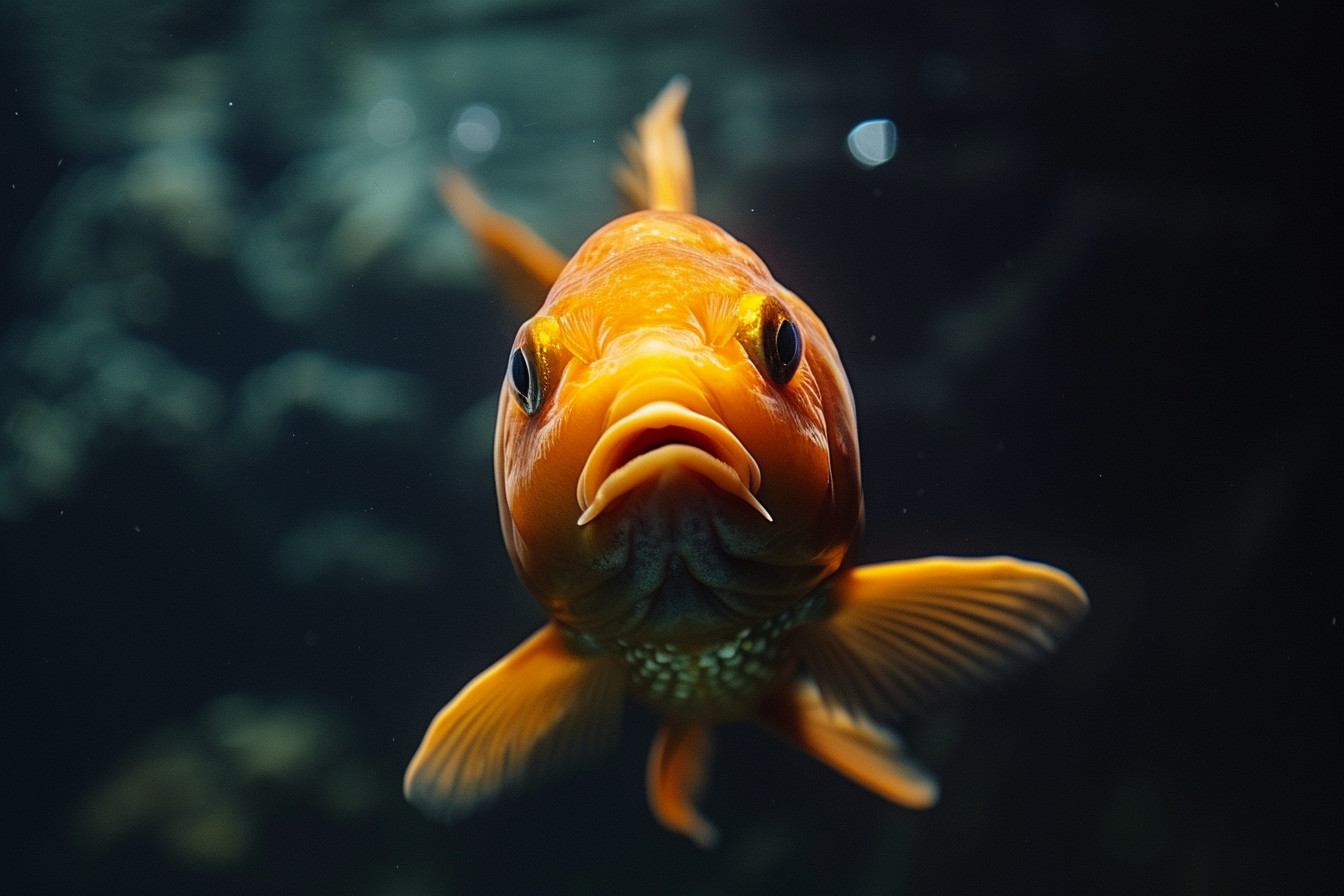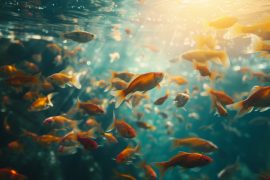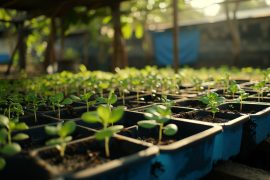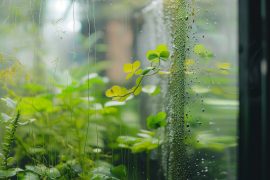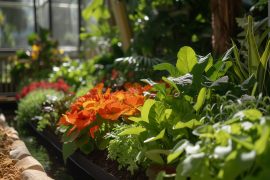So, let’s talk about something really cool that happens in the world of gardening, specifically in aquaponics. Aquaponics is this amazing system where fish and plants kind of become best buds, helping each other thrive without the need for soil or chemical fertilizers. Imagine having a peaceful little ecosystem right at your fingertips! It’s not just fascinating; it teaches us a lot about harmony and sustainability.
One thing I’ve learned from setting up my own aquaponic garden is how these symbiotic relationships work wonders. The process begins with fish doing what they do best: eating and producing waste (it sounds gross, but stick with me). Then comes the magic part—the waste isn’t wasted at all. Actually, plant roots filter out this waste to absorb nutrients essential for their growth while simultaneously cleaning the water, which goes back to keeping our finned friends happy—a perfect give-and-take relationship!
What mesmerizes me most, though, isn’t just how well fish and plants get along—it’s witnessing nature’s balance firsthand every day within such an interconnected setup. This brilliant connection does more than grow food; it grows respect between humans and Mother Nature by reminding us that everything has its role, no matter how small we think it may be. Plant on one side, fish on the other. Together, we create life. There’s beauty there, don’t you think?
Why Should You Care About This Symbiotic Symphony?
- Saves Water: Uses up 90% less water compared to “traditional” agriculture.
- Eco-Friendly and Sustainable reduces reliance on pesticides and chemical fertilizers within controlled environments; no runoff pollutes lakes and rivers around us.
| Benefits | Description |
|---|---|
| Efficiency | Faster growth rates are due to constant access to all that good stuff (nutrients). |
| Space Conservation | Vertical stacking options mean more yield per square foot than conventional plots. |
You might have heard stories about folks converting their garages and backyard spaces into lush vertical farms—thanks in part to genius systems! They talk proudly, yielding leafy harvests. bucketloads Tilapia is merely whispering sweet things. Mother Nature is kind of badass if you ask me, especially thinking about how to decrease carbon footprints by embracing processes.
Nestled amongst my own gardening adventures, I stumbled across countless tales of successes and failures alike, both equally inspiring. Their narratives paint vivid images that seem to forged mutual respect and understanding balance between elements, symbolizing greater connection. Earth-nurturing hands yield far-reaching fruits, vegetables, and even peace of mind. The learning curve isn’t steep, and it seems many people from walks and signing boards who promise an efficient, harmonious way to feed the planet are finding profound satisfaction watching tiny ecosystems flourish under care.
They just can’t help but marvel at the intricacies nature designed perfectly to operate hand-in-hand. Who knew it could be such an educational, technical, yet accessible time?
The Basics of Symbiotic Relationships
Diving into the world of aquaponics is like exploring a beautifully delicate dance between fish and plants. Here they are, two vastly different forms of life intricately linked in a way that benefits them both—now, isn’t that something? This harmony is what we refer to as symbiosis. So let me break down this complex term with some simple examples.
Imagine you’re running a small café together with your friend; you’re great at baking cakes but not so keen on making coffee. Your friend loves brewing coffee but can’t bake to save their life. By combining forces, you complement each other perfectly, ensuring everyone gets their cake and drinks too! Similar things happen underwater in an aquaponic system.
Fish produce waste—there’s no poetic way around it, really (it happens!). But instead of being problematic, as one might initially think about poop underwater or anywhere else for that matter (let’s face the truth here), plant roots take up these wastes, using them as nutrients. How clever, right? It’s essentially recycling: Nature teaches us efficiency through its intrinsic processes once again.
- Plants remove toxins from the water.
- Fish provide essential nutrients.
Not only does this partnership keep our finned friends healthy by purifying waters that could otherwise harbor harmful substances over time if left untreated, but everything within such setups grows faster since these systems maximize nutrient availability, unlike traditional mono-culture farming practices where resources often get depleted quickly, leading farmers scrambling for alternatives and eventually turning back soil older than dirt itself laden with heavy synthetic fertilizers. Did you catch my drift?
Understanding the Role of Fish in Aquaponics
Diving into aquaponics, we quickly realize that fish aren’t just another pretty face in our garden; they’re hard at work behind the scenes. It’s fascinating how these slippery friends become such pivotal players. They do more than just swim around looking cute, though I’ll admit, that’s definitely a perk.
First off, let’s break down what makes fish so essential here. They’re not only part of this symbiotic relationship but actually fuel it with their waste—yeah, you heard me right! As they go about their day munching on food, what comes out the other end is pure gold for plants. This natural process turns ammonia from fish poo and pee (sorry for getting technical there) into nitrites and then nitrates through bacteria found naturally in water systems, which acts as an all-you-can-eat buffet for plant roots hanging out eagerly above.
Now you might be wondering about specifics like “What kind of magic fish are these?” Well, let me tell you’, nearly any freshwater species does well, but tilapia and carp have gained some serious popularity among enthusiasts due to their adaptability and hardiness, making them perfect candidates, especially if you’re new to this whole gig or live where temperatures can dip lower than your average bear likes it cold.
Here’s something cool: Many folks dabbling in aquaponics love experimenting with different breeds, boosting biodiversity along with bragging rights when those unique or exotic varieties thrive under care. Nothing short of attentive gardening genius meets aquatic aficionado dedication levels!
Exploring the Connection Between Fish and Plants
Diving right into it, let’s talk about how fish and plants in aquaponics are basically BFFs. Picture this: You’ve got your tank full of fish doing their thing—swimming around, eating food—and life is good for them. But there’s a twist: they’re not just living their best lives by themselves; they’re actually part of something bigger.
So those little guys produce waste—I mean, who doesn’t? Normally, that’d be kind of a problem to manage, but stick with me here because that’s where the magic happens. This waste becomes an all-you-can-eat buffet for bacteria, which turns it into nitrates—a form of nitrogen that plants absolutely love.
Now swap over to our green friends roots dipped in water, absorbing these converted nutrients like it’s going outta style while simultaneously filtering this water clean again for the fish—it’s textbook give-and-take! They literally live off each other’s leftovers, making everything sustainable!
Let me lay down some numbers, because everyone loves seeing things stack up:
| Component | Benefit |
|---|---|
| Fish | Produce wastes rich in nutrients. |
| Bacteria | Convert waste into plant-ready nitrates. |
| Plants | Absorb these nutrients, cleansing the water. |
Adding real-world spice to our scenario—I once visited a setup combining tilapia with lettuce thriving together so harmoniously you’d think they signed a peace treaty at birth!
And what really sealed my belief were stats showing setups like these can grow vegetables up to twice as fast as conventional farming methods without ever needing synthetic fertilizers or pesticides—truly, nature is working its wonders unconstrainedly.
We don’t need heavily processed chemicals when we’ve got ecosystems, and demonstrating teamwork makes the dream work every day! Witnessing such partnerships has opened my eyes—they’re more than just survival tactics; they’re reflections on mutual respect forging paths towards sustainability.
In essence, coming face-to-face—or, should I say, fin-to-root—with such connections within aquaponic systems raises the question of why we didn’t buddy up with fish and plants sooner. It crafts an efficient loop stressing less on resources, producing heaps yet leaving minimal footprints behind—an ode if anything celebrating convivial ties binding aquatic residents and algae stretchers alike toward collective prosperity.
Types of Symbiotic Relationships in Aquaponics
Diving into the world of aquaponics feels a bit like uncovering a secret garden where everything’s connected in the most unexpected ways. The heart and soul? Well, it’s all about symbiosis—that beautiful partnership between fish and plants thriving together. So let’s chat about how this magic happens.
First off, mutualism is our headline act here. It sounds fancy, but stick with me; it’s straightforward yet fascinating! In an aquaponic system, our finned friends (the fish) do their thing—eat food and produce waste.
Now you might think “waste”—yuck!, right? But here’s where things turn delightful: This so-called “waste” isn’t wasted at all! Plants come into play by absorbing these nutrient-rich effluents to grow healthily, turning what could be a problem into prime plant food instead of letting anything go to toxicity levels for the aquatic residents.
But wait, there’s more, because nature loves variety:
- Commensalism also has its moment under these watery spotlights, though it is less common than mutualistic relationships. Here, one party gets plenty out of living together, while another doesn’t gain or lose much from cohabitation dancing.
Imagine water snails gently cruising along surfaces, not disturbing anyone or anything else around them. They’re getting clean, algae-eaten environments, and they love providing indirect benefits to other community members who’d rather not deal with slippery guests on leaf roots!
Lastly, don’t forget predation. Yup, every balanced ecosystem needs some element of predator-prey dynamics to maintain healthy populations. Keep everyone checked, and remember, we’re looking for harmonic balance. simple cases of small crustaceans becoming snack-sized inhabitants Can be somewhat unsettling sure, however,is a vital part of circle life guaranteeing no species dominates others excessively and ensuring diverse flourishing space for everybody involved.
In short, diving deep through layers The tranquility and wisdom found within shared gardens teach us invaluable lessons. unity resilience With each breathless dive beneath the surface, we uncover new wonders. cooperation, survival, and crafting narratives hope possibility Discoveries made clear waters Reflections of our intertwined lives carry whispers of the natural order. Brilliance awaits those willing to listen, learn, and adapt, transforming mere observers into active participants in grand symphonic convergence powered solely by bonds. fellowship understanding
Mutualism: A Win-Win for Fish and Plants
Dive into the heart of an aquaponics system, and you’ll discover a world where fish and plants coexist in one beautifully orchestrated ecosystem. This mutualistic relationship—where both parties not only survive but thrive—is quite fascinating. Let’s unpack how this synergy benefits everyone involved.
At its core, aquaponics marries aquaculture (raising fish) with hydroponics (growing plants without soil), creating a closed-loop system that mimics natural water bodies’ ecosystems. Here’s the scoop: fish produce waste materials that are not good for them, but guess what?
These wastes contain ammonia, which is like gold for plant growth when converted to nitrates by beneficial bacteria found in the water. It’s all about give-and-take. The plants absorb these nutrients to grow healthier while simultaneously cleaning the water that cycles back to keep our finned friends happy.
Alright, so why do folks get jazzed up about this setup, besides it sounding super cool? Well, here are some numbers I dug up:
| Benefits | Description |
|---|---|
| Water Efficiency | Uses up to 90% less water than traditional agriculture methods. They save every drop! |
| Space-Saving | It can be set up vertically, making it ideal even in urban spaces where ground space is at a premium. Climb up those tiers, veggies! |
| Chemical-Free | *ROUTINE HIGH-FIVE** FOR being organic BY default SINCE chemical fertilizers ARE big NO-NO HERE if we want kept FISH alive |
Commensalism: Benefits for One, No Harm for the Other
When diving into the world of aquaponics, it’s fascinating how nature orchestrates its partnerships. Take commensalism, for instance; this type of relationship is where one party gets all the perks while the other isn’t affected much at all. It might sound a bit unfair if you’re picturing dinner invitations, but in ecosystems like those created in aquaponic systems? Well, it’s pure harmony.
Now let me paint a picture with an example that’s as clear as day: certain types of bacteria and your average fish living together in an aquaponic tank. Here, these microorganisms have hit life’s jackpot by feeding on fish waste (I know that sounds gross; hang tight!). As they convert ammonia from this waste into nitrates, plants are screaming out to gulp it down. Not only does our scaly friend continue swimming unmoved, his unintentional support fuels plant growth without him even batting an eye or, well, fin.
- The Fish: Minding their own business.
- Bacteria: Thriving! They munch on what would be a harmful buildup otherwise.
Parasitism: The Dark Side of Symbiosis
When we talk about aquaponics, there’s usually a lot of enthusiasm around how fish and plants can help each other grow. But it’s not all sunshine and rainbows, because sometimes in this underwater world, relationships turn sour. Case in point? Parasitism.
This is where one organism benefits at the expense of another—kind of like that friend who always takes but never seems to give back. In the realm of aquaponics, certain parasites latch onto fish or plants, thriving while their hosts suffer.
For instance, let’s take a dive into an example involving our close friends. Ichthyophthirius multifiliis (try saying that five times fast), commonly known as “Ich,” turns out to be one sneaky parasite affecting freshwater fish worldwide! It feeds on the tissues and blood of its host, causing infections that can lead to severe damage if left unchecked. While most parasitic concerns lean towards problems for aquatic lifeforms, they can also indirectly affect plant health by destabilizing nutrient cycles within system mechanics, thus posing potential harm across the board.
Now here are some numbers you might find startling:
| Parasite | Impact Rate (%) |
|---|---|
| Ich | Upwards 90% |
As troubling as these cases may seem, diving deeper reveals plenty of awareness exists among practitioners wrestling with ways of resisting pestilence without undermining delicate balances and nurturing those symbiotic alliances between flora and fauna presiding over water gardens ’round the globe.
Don’t get me wrong. I’m enamored by the eco-friendly cyclical intricacies forged through centuries of human interaction with natural environments, especially those mimicking nature closed-loop; seeing however shade even amongst the brightest rays of sunlight serves to remind vigilance and self-education importance when fostering such partnerships.
On a brighter note, sharing stories, best practices, communal wisdom, and encouragement could serve to remedy the darker aspects. Collaborations forge paths forward, emphasizing resilience and resolving community challenges. head-on, protecting shared ventures from unwanted guests, ensuring their success far beyond the initial setup stages toward sustainability and prosperity generations follow…
Maintaining an Effective Symbiotic Relationship
Keeping a harmonious balance between fish and plants in aquaponics isn’t just smart gardening; it’s like conducting a symphony where each living component plays its part beautifully. For me, finding that sweet spot is one of the most rewarding challenges.
Fish waste provides an organic food source for the plants, while the plants clean up water, which benefits our aquatic friends. Sounds simple enough? Sure does! But getting into the nuts and bolts—or should I say fins and roots—there are essential steps to ensure this relationship thrives:
- Monitor water quality religiously. The secret sauce to success lies within parameters such as pH levels, ammonia, nitrites, and nitrates embedded in your system’s lifeblood. Water coping with fluctuation requires regular testing.
Managing these invisible yet crucial elements makes sure everyone gets along swimmingly!
- Feed your fish wisely. Knowing what goes into your system is pretty much half the battle won by ensuring a diet appropriate for fish species, sustaining their health, and controlling indirect nutrients. feed available plant buddies moderation key excess disrupts fine-tuned mechanism Never underestimate the power of a good feeding schedule.
One anecdote really sticks out: we once had tilapia-prone overfeeding versus leafy greens struggled with nutrient overload, intervening early and adjusting quantities brought back. Equilibrium teaches invaluable lessons too little—just the right art and science intertwined in a delightfully complex way.
Temperature deserves a shoutout here; both flora and fauna are sensitive to extremes. Keeping an eye on mercury helps avoid issues. Stimulated growth disease proliferation—after all, nobody likes being uncomfortable, whether human-financed or not. Maintaining consistent conducive thriving is quite important, and potentiometer heaters can help dial in the perfect environment.
At heart, cultivating effective symbiosis means listening, observing, and reacting to the cues nature offers. It feels like a peaceful moment, realizing myriad connections and interdependencies. Cultivate patience and attention to detail, but reward seeing blossoming eco-systems own making absolute joy. Journey may require a bit of trial and error, but fruits labor indeed, in a very literal sense.
Final Thought
This has been quite the journey through the harmonious world of aquaponics. Diving into how fish and plants coexist so beautifully in this system, it’s clear there’s something special here. Aquaponics isn’t just about growing food; it’s a glimpse into nature’s soul, where every participant thrives on mutual support.
What struck me most was learning how these relationships aren’t just beneficial but essential for success. The fish provide nutrients to the plants, which, in turn, clean up their water—it truly is teamwork at its finest! This cycle mimics natural ecological systems, showcasing resilience and efficiency that can teach us plenty about sustainability.
